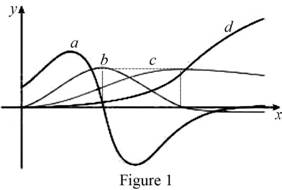
To identify: Each curves on the given graph and give proper explanation.
Answer to Problem 44E
In the given graph, d is position curve, c is velocity curve, b is acceleration curve and a is the jerk curve.
Explanation of Solution
Note: Let f and
Graph:
The given graph is shown as in Figure 1,

Observation:
From Figure 1, the point where
Recall that the derivative of a function is zero where the function has a horizontal tangent.
The curve
Thus,
Observe the graph of b and c carefully.
The point where
Recall that the derivative of a function is zero where the function has a horizontal tangent.
The curve
Thus,
From (1) and (2),
There are two possibilities:
Observe the graph of d and a carefully.
The points where the graph of a has horizontal tangents, the functional value of d is not zero at that points.
This implies that
The only possibility is that a is the acceleration curve.
This implies
Thus d is position curve, c is velocity curve, b is acceleration curve and a is the jerk curve.
Chapter 2 Solutions
Single Variable Calculus: Concepts and Contexts, Enhanced Edition
 Calculus: Early TranscendentalsCalculusISBN:9781285741550Author:James StewartPublisher:Cengage Learning
Calculus: Early TranscendentalsCalculusISBN:9781285741550Author:James StewartPublisher:Cengage Learning Thomas' Calculus (14th Edition)CalculusISBN:9780134438986Author:Joel R. Hass, Christopher E. Heil, Maurice D. WeirPublisher:PEARSON
Thomas' Calculus (14th Edition)CalculusISBN:9780134438986Author:Joel R. Hass, Christopher E. Heil, Maurice D. WeirPublisher:PEARSON Calculus: Early Transcendentals (3rd Edition)CalculusISBN:9780134763644Author:William L. Briggs, Lyle Cochran, Bernard Gillett, Eric SchulzPublisher:PEARSON
Calculus: Early Transcendentals (3rd Edition)CalculusISBN:9780134763644Author:William L. Briggs, Lyle Cochran, Bernard Gillett, Eric SchulzPublisher:PEARSON Calculus: Early TranscendentalsCalculusISBN:9781319050740Author:Jon Rogawski, Colin Adams, Robert FranzosaPublisher:W. H. Freeman
Calculus: Early TranscendentalsCalculusISBN:9781319050740Author:Jon Rogawski, Colin Adams, Robert FranzosaPublisher:W. H. Freeman
 Calculus: Early Transcendental FunctionsCalculusISBN:9781337552516Author:Ron Larson, Bruce H. EdwardsPublisher:Cengage Learning
Calculus: Early Transcendental FunctionsCalculusISBN:9781337552516Author:Ron Larson, Bruce H. EdwardsPublisher:Cengage Learning





